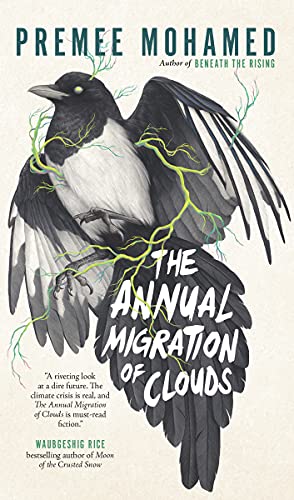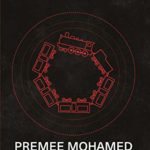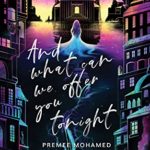Premee Mohamed’s beautiful novella (her third this year)The Annual Migration of Clouds, while set in a dystopian future, is more about a young woman saying goodby and leaving home, like birds leaving the nest, seasons turning, the movement of natural forces. It focuses on hard-won hope in the face of uncertainty rather than the devastating loss of a broken world.
The Annual Migration of Clouds dramatizes the breaking away of nineteen year-old Reid from a remarkable and close-knit community. It has survived the multiple terrible storms and other catastrophes tearing down all communication, transportation and government institutions that had once bound the world together.
The story opens with her receiving a letter of acceptance (a chance in a million) to a university that is thought to exist (no one is really sure) within one of the great domes where the wealthy of the world protected themselves from environmental and economic collapse. It’s believed that much of the technology of the past world, known as the Back Then, survives in these enclaves, but no one really knows.
The rest of the story (and I don’t think I’m giving away too much here) is about leaving home rather than arriving in a new place. Reid is beset by doubts as her mother tries to hold her back, pleading that she can’t be spared from the subsistence community that has survived on the campus of an abandoned university. Everyone has a well-defined role to play. Reid’s mother is getting older, and both she and her daughter have a heritable fungal disease known as Cad for short. Her mother plays quite effectively on Reid’s guilt about leaving while other members of the community cheer her on to make the move.
Cad, as a symbiont with a mind of its own, becomes another character trying to control Reid’s life. Untreatable, capable of causing horrible disfigurement and death, it pushes her toward safety to protect itself, at times physically hindering her movements or making her curl up in a ball of fear. In an interview, Mohamed says she found in the phrase “heritable symbiont” the initial inspiration for the story, but the world and characters she built from this starting point quickly transcend the idea of a disease that can affect human behavior. Even the threat of this illness doesn’t stop Reid. Though its influence poses the question of whether or not its victims are capable of free will and truly making their own decisions, she constantly fights against it.
Though racked with doubt and guilt, she pushes through the physical dangers and her inner critic to try one new experience after another. Her testing of wings (the story is full of bird imagery) is nowhere more powerfully described than in a wild and disastrous adventure she undertakes in joining a hunt for feral pigs. That brilliantly written segment made me think for a moment that I was back in the world of Faulkner’s great story, The Bear, with its rapid-fire action.
But there is no simple outcome for any part of Premee Mohamed’s world. There is always danger and loss, blood is spilled, terrible wounds remain to survivors like Reid. As with Cad, that shows its presence in branching patterns under the skin, threats are never far from the surface, and Reid will have to take the physical wounds of the past with her wherever she goes.
There are unanswered questions inevitably in Reid’s tortured weeks leading up to her decision about whether to leave or not. Her role in the community, her relationship with her mother, her near romance with Henryk, her friend from childhood, her friendships with old family friends, her illness, all confront her with pressures to stay, to change, to take chances, to play it safe. She has to still all those voices so that she can finally hear her own, but it’s a messy process that takes its toll.
In the end, though, I find this a profoundly hopeful book on many levels. For one, the community Mohamed brings to life, though it has its violent side, is a model of cooperation in spite of the scavenging life it imposes on its members. Food is harvested from gardens and hunting and is shared through a system of bartering. Mounds of trash plastic left behind by the Back Then world is carefully spun into thread for cloth. Nothing is wasted, no one is forgotten, all add their bit to keep things going.
Most of all it is hopeful about the possibility for agency on the part of a nineteen year-old. In the midst of deprivation of a post-apocalyptic world, a devastating illness, the lack of information and certainty, even about the existence and location of the university she may be going to, Reid still pushes through to make a choice of her own. The ending is messy, the choice leaves its wounds, no one is sure what will happen next, but there remains a broken legged kind of hope.
I’m so impressed with the depth of Premee Mohamed’s three novellas published this year: What Can We Offer You Tonight, These Lifeless Things and The Annual Migration of Clouds. She demonstrates a wonderful range in these stories, merging elements of fantasy and science fiction but always rooting them in fully realized characters. And there is always her beautiful writing, no matter what she may be describing. Don’t miss these stories.





Leave a Reply